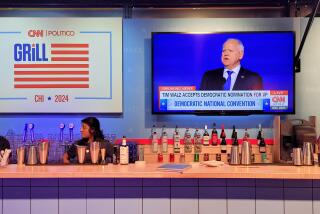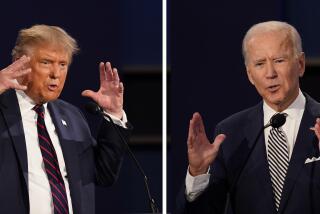C-SPAN Hopes to Have All Convention Angles Covered
- Share via
PHILADELPHIA — No-nonsense C-SPAN may be the closest thing television viewers can get to impartial, straightforward gavel-to-gavel coverage of the official Republican National Convention podium action. But for viewers who worry that even C-SPAN may be distorting the picture, the cable network has a solution: a camera in the C-SPAN control room pointed over the shoulder of the person directing the C-SPAN coverage.
The camera is just the latest extreme exhibition in the most popular convention sideshow: debating how the media cover the highly scripted nominating conventions. The camera, which can be accessed through C-SPAN’s Web site (https://www.C-SPAN.org), allows viewers to see how director Gary Ellenwood puts together the C-SPAN coverage, choosing from 16 cameras stationed in and around the convention. And because he’s wearing a microphone, they can listen in as he tells a cameraman to pull back or pan around the convention hall, or zoom in on a delegate in a goofy hat.
It isn’t just C-SPAN that is airing the Ellenwood-chosen pictures; as the official “pool” operation for the convention, the C-SPAN video feeds are the exclusive camera shots from many locations inside the convention hall, and they are made available to other broadcast and cable networks for use on their own broadcasts. While the cable news networks and public television all have extensive prime-time coverage of the activities, C-SPAN has by far the most full-day podium coverage, all of it repeated overnight. And it’s doing that job with about 100 employees, a fraction of what most television operations bring.
(As part of C-SPAN’s devotion to covering how the convention is covered, it will also run a tally every night, once the official activities are wrapped up, of how many minutes each broadcast and cable news network devoted to the convention.)
*
With the technical quality of a broadcast riding on their shoulders, directors have some of the highest-pressure jobs in the live television news business, and they can get notoriously worked up in the heat of the moment. Ellenwood calls himself “an old-school director: You do what you need to do, and if apologies need to be made, they can come after.”
Although he’s not directing an unpredictable event such as riot coverage, Ellenwood says he expects the control room will “definitely get hairy.” He’s not as worried about letting an improper word slip out, he says, as he is about his ability to get the shots he wants from his camera operators without shocking viewers unused to the behind-the-scenes process.
Despite the pressure that it will add to his job, Ellenwood, who has directed six previous conventions for C-SPAN, supports the control room camera. “Showing the sausage being made is part of what C-SPAN is about. We’re not afraid.”
With 16 cameras, including one that will be used just for an up-close and personal shot of George W. Bush’s arrival in the hall Thursday night, C-SPAN has almost doubled the number of video shots at its disposal from four years ago. Technological advances making cameras smaller and even robotic mean that there can be more cameras without the added personnel costs to operate them. C-SPAN is using two robotic cameras inside the convention hall; it also has two hand-held cameras. Four of the C-SPAN cameras, in addition to the control room camera, can be accessed from the cable channel’s Web site.
Viewers are unlikely to find much bias in the way Ellenwood puts the show together. C-SPAN is so fastidious that it went to great lengths when choosing camera locations for the Democratic National Convention, taking place in Los Angeles Aug. 14-17, to make sure the angles will be exactly the same as they are for the Republicans, despite the different size and configuration of the Philadelphia and Los Angeles convention halls.
More to Read
Get the L.A. Times Politics newsletter
Deeply reported insights into legislation, politics and policy from Sacramento, Washington and beyond. In your inbox twice per week.
You may occasionally receive promotional content from the Los Angeles Times.










